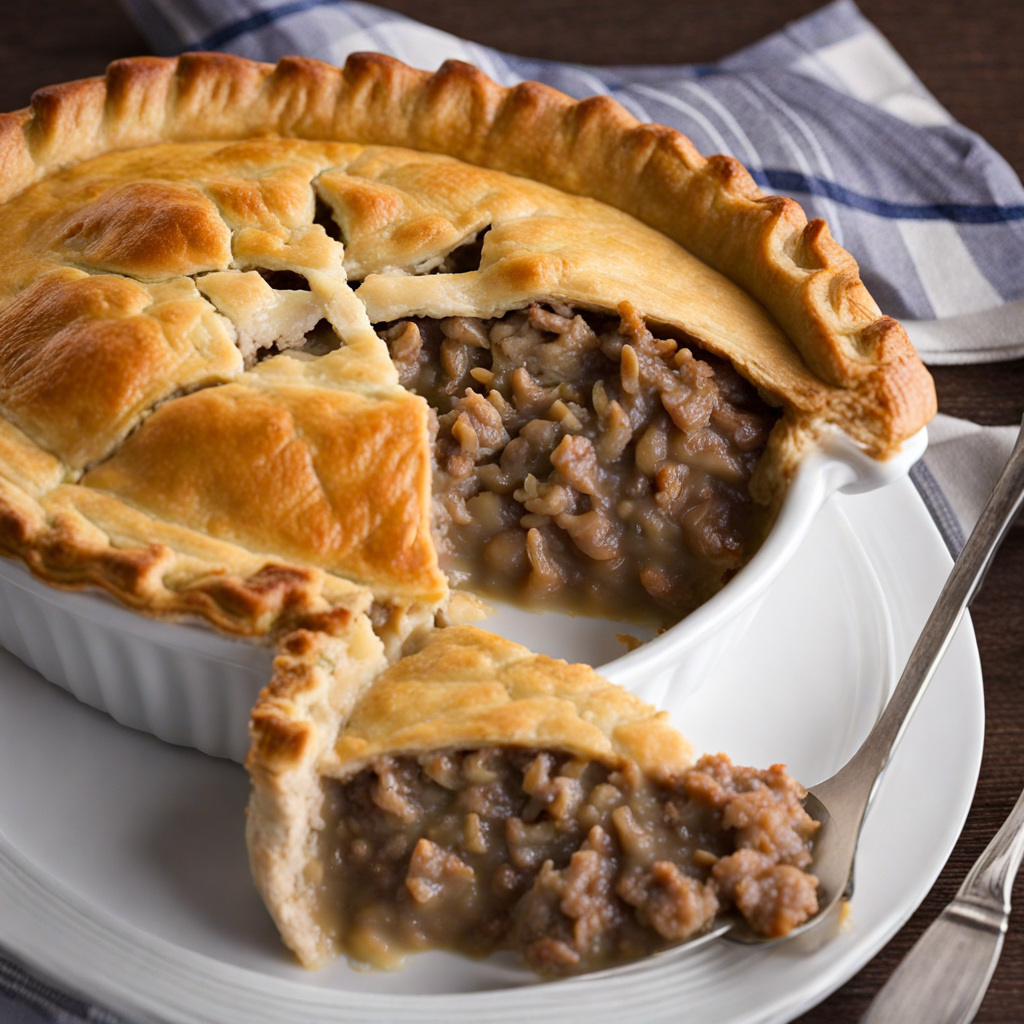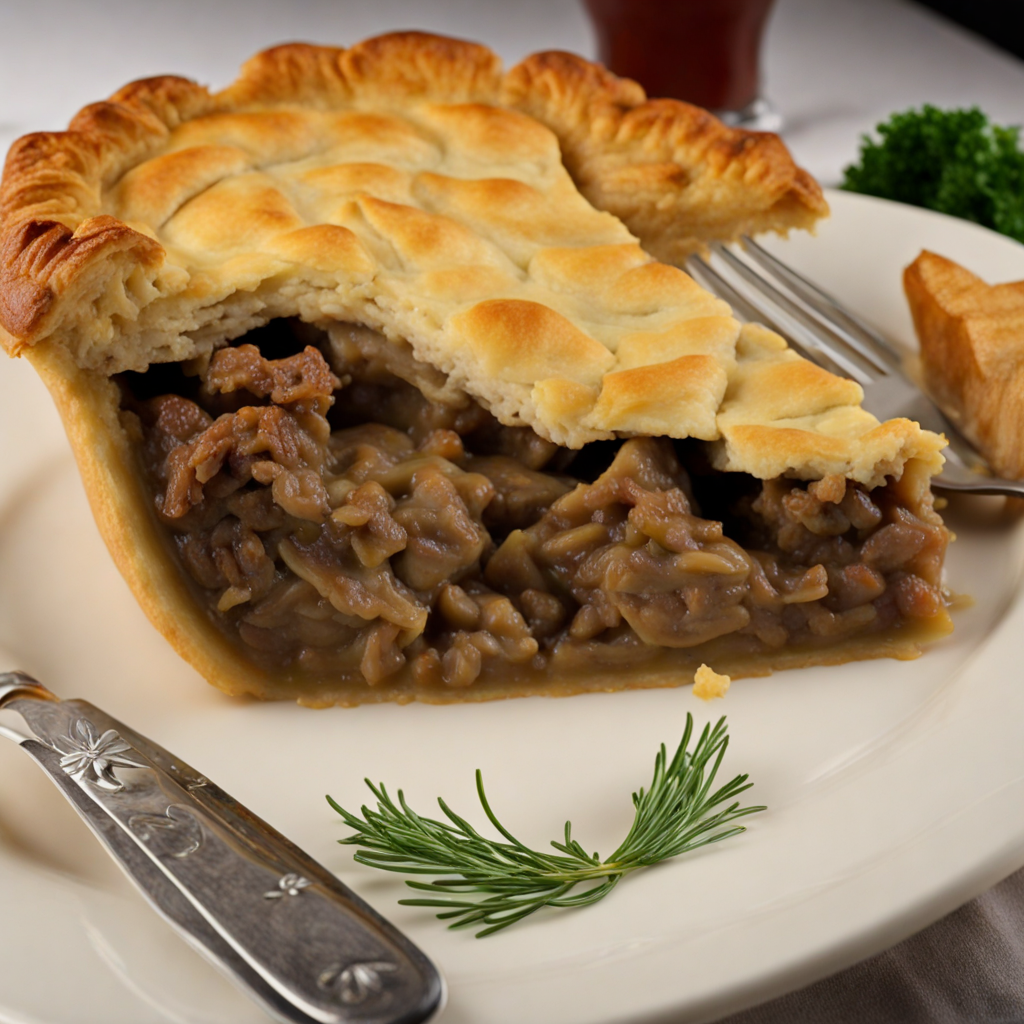Tourtière
Tourtière is a traditional meat pie originating from Canada, particularly associated with Quebec and the French-speaking regions of the country. This savory pie is typically made from a flavorful mixture of ground meats, which can include pork, beef, or game, seasoned with a blend of spices such as cloves, nutmeg, and cinnamon. The combination of meats and spices creates a rich and aromatic filling that is encased in a flaky, buttery pastry crust. Often enjoyed during the festive season, Tourtière has become a cherished symbol of Canadian culinary heritage, reflecting the country's diverse cultural influences. The preparation of Tourtière varies from family to family, with each recipe embodying unique regional and personal touches. While the classic version is baked until golden brown, some variations might incorporate potatoes or other vegetables into the filling for added texture and heartiness. The pie is usually served hot, accompanied by a side of tangy pickles or a dollop of spicy mustard, which enhances the savory flavors. The first bite reveals a delightful contrast between the crispy crust and the tender, well-seasoned meat, making it a comfort food that warms the soul. Tourtière is not just a dish; it is an experience that connects people to their roots and shared traditions. As you savor each mouthful, you will find that the spices evoke memories of family gatherings and festive celebrations. This beloved pie has transcended its origins, becoming a staple in Canadian homes and restaurants alike, inviting food enthusiasts to explore its depths. Whether enjoyed during the holidays or as a comforting weeknight meal, Tourtière promises a unique taste journey that captures the essence of Canadian culture.
How It Became This Dish
The History of Tourtière: A Culinary Tradition of Canada #### Origins and Early Beginnings Tourtière, a savory meat pie, is one of the most cherished dishes in Canadian cuisine, particularly associated with the province of Quebec. Its origins can be traced back to the early French settlers in North America. These settlers, arriving in the 17th century, brought with them culinary traditions from France, including the concept of meat pies. The name "tourtière" itself is derived from the "tourte," a term used in France for a pie or tart. The earliest versions of tourtière were likely quite different from what we know today. The settlers used a variety of meats that were readily available in their new homeland, including pork, game, and even fish. The use of local ingredients was not only practical but also a necessity, as the early settlers had to adapt to their environment. The pie was often seasoned with spices such as nutmeg, cinnamon, and cloves, reflecting the influence of both French and indigenous culinary practices. #### Cultural Significance Tourtière is more than just a dish; it embodies the cultural heritage of Quebec and the broader Canadian experience. It is traditionally served during the Christmas season, symbolizing warmth, family gatherings, and celebration. In many homes, the preparation of tourtière is a family affair, passed down through generations, with each family adding their unique twist to the recipe. In Quebec, tourtière is closely associated with the "Réveillon," a festive meal that takes place on Christmas Eve. Families gather to celebrate with a grand feast, and tourtière often takes center stage. The dish has become a symbol of Quebecois identity, representing the melding of French culinary traditions with local Canadian ingredients. In fact, many Quebecois families consider it almost sacrilegious to celebrate the holidays without at least one tourtière gracing the table. #### Development Over Time As the years progressed, tourtière evolved both in its ingredients and its preparation. The early 20th century saw a shift in the types of meat used in tourtière. While pork remained the primary ingredient, the inclusion of game meats—such as rabbit, venison, or wild boar—became popular, reflecting the hunting culture prevalent in rural Quebec. Additionally, the rise of industrialization and urbanization in the mid-20th century led to the mass production of tourtière, making it more accessible to a broader audience. Regional variations of tourtière also emerged as different communities put their own spin on the dish. In the Bas-Saint-Laurent region, for instance, the pie is often made with a combination of pork and beef, while in the Saguenay-Lac-Saint-Jean area, a much richer version includes a higher proportion of pork and is sometimes accompanied by a sauce made from broth and spices. Each variation tells a story of the local ingredients available and the culinary practices of the community. The late 20th and early 21st centuries saw a renaissance of traditional foods in Canada, with chefs and home cooks alike revisiting and reinventing classic recipes. This resurgence brought tourtière into the spotlight, leading to a renewed interest in artisanal and locally sourced versions. Modern cooks often experiment with alternative crusts, fillings, and presentations, keeping the spirit of the dish alive while adapting it to contemporary tastes. #### The Modern Era: Tourtière Today Today, tourtière is a staple in many Quebecois homes and can be found in bakeries, restaurants, and grocery stores across Canada. The dish has gained popularity beyond Quebec, as Canadians from other provinces have embraced it, particularly during the holiday season. Nationally, the dish is often featured at winter festivals, and even fine dining establishments offer gourmet interpretations of this classic. The introduction of vegetarian and vegan versions of tourtière reflects the growing trend toward plant-based diets. Modern interpretations often use lentils, mushrooms, and an array of spices to mimic the savory flavors of traditional meat pies, allowing a wider audience to enjoy this beloved dish. Tourtière has also found its way into popular culture, appearing in Canadian literature and media, symbolizing home and heritage. In Quebec, it is not uncommon to hear stories of families who have their own secret recipes, often guarded with pride. Cookbooks dedicated to Quebecois cuisine frequently feature tourtière, illustrating its enduring appeal and significance in Canadian culinary history. #### Conclusion Tourtière is more than just a meat pie; it is a testament to the rich culinary history of Canada, particularly that of Quebec. This dish reflects the fusion of French traditions with local ingredients and indigenous practices, symbolizing the resilience and adaptability of the people who made Canada their home. As it continues to evolve, tourtière remains an essential part of Canadian culture, connecting generations through shared recipes and cherished memories. Whether enjoyed at a holiday feast or at a rustic gathering, tourtière continues to warm hearts and homes, embodying the spirit of community and the joy of sharing a meal. In every bite, one can taste the history, tradition, and love that have made tourtière a beloved dish for centuries.
You may like
Discover local flavors from Canada







